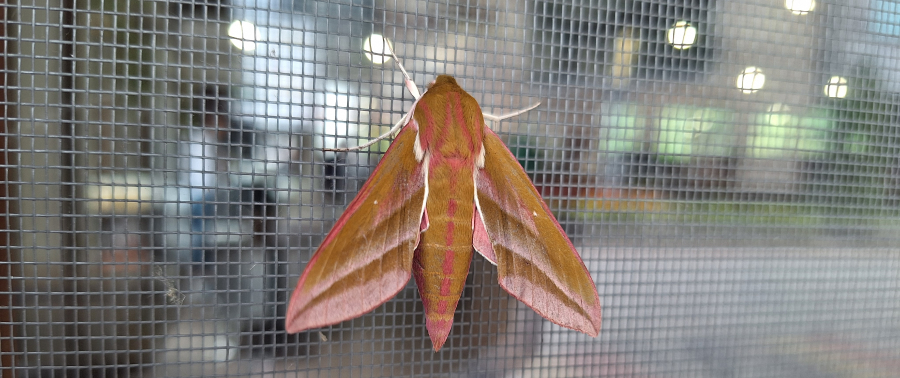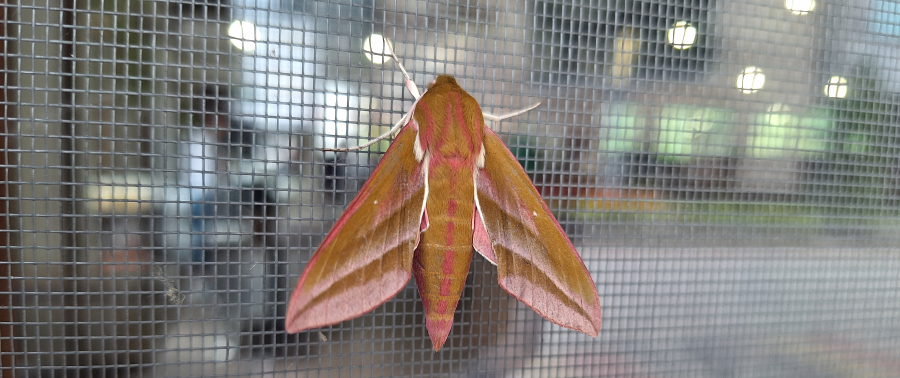

Continuăm să publicăm o serie de materiale despre flora și fauna din Bukovel.
Astăzi, din nou despre insecte.
Ați întâlnit pe teritoriul stațiunii un fluture strălucitor cu aripi verde-purpuriu? Aceasta este molia vinului (lat. Deilephila elpenor) – unul dintre cei mai spectaculoși și mai strălucitori fluturi de noapte din Carpați.
Iată informații interesante despre molia vinului – un fluture care uimește adesea prin aspectul și comportamentul său.
Aspect
Are o culoare extrem de strălucitoare: o combinație de culori roz-purpuriu și verde-măsliniu pe aripi și corp.
- Anvergura aripilor – aproximativ 45-60 mm.
- Și-a primit numele de „vin” tocmai datorită culorilor care seamănă cu strugurii sau vinul.
- Omida este mare, închisă la culoare, cu „ochi” bizari pe partea din față, imitând capul unui șarpe, speriind prădătorii.
Cu ce se hrănește?
- Fluturii adulți se hrănesc cu nectarul florilor în principal la amurg și noaptea: le plac în special plantele cățărătoare, cum ar fi nectarul de caprifoi, brumărele etc.
- Omida se hrănește în principal cu hamei, chiparos, fuchsia, Ivan-ceai, gălbenele, struguri și alte plante, uneori chiar și cu flori ornamentale.
Oaspete de noapte
Acesta este un fluture nocturn, activ în principal la amurg și noaptea, când zboară din floare în floare. Fluturii de noapte sunt zburători excelenți și pot atinge viteze considerabile (până la 50-60 km/h).
Fluturele de noapte are o trompă lungă, cu care poate extrage nectar din flori foarte adânci, plutind în fața lor în aer – ca niște colibri.
Curiozități
- Mimetismul omizii – asemănarea sa cu un șarpe o protejează de păsări și alți prădători.
- Înainte de a deveni pupă, omida devine maronie și moale, caută pământul, unde sapă și formează o pupă.
- Molia șoimului de vin nu dăunează grădinilor sau câmpurilor. Nu este un dăunător – este un polenizator util.
- Se găsește în toată Europa, în special în Ucraina, mai ales în Carpați, Polissya și zona de silvostepă.
Acest fluture poate deveni cu ușurință... creatura de companie. Da, da, nu este o glumă. Totuși, nu va răspunde la o poreclă, nu va murmui în ureche – nici nu va fi rugat să meargă în lesă și nu trebuie să-l duci la veterinar.
Chestia este că molia șoimului de vin este unul dintre fluturii care, dacă este întreținut corespunzător, se simte excelent în captivitate. O anumită temperatură, umiditate, iluminare, nutriție și imitarea mediului natural sunt condiții care contribuie la un comportament de hrănire activ, în care adulții formează rapid perechi și depun un număr mare de ouă (până la 150).
Notă: apariția acestui fluture în natură este un semn al unui mediu curat, deoarece trăiește doar în locuri echilibrate ecologic.
A vedea molia șoimului de vin este un semn de noroc. Acesta este un adevărat fluture de artist, care este pictat precum cerul de seară din Munții Carpați!
Anterior, în seria de publicații despre flora și fauna din Bukovel, am vorbit despre albinele sălbatice, peștii Lacului Tinereţii, tritonul carpatin, veverița carpatică și salamandra.
În fotografie: am văzut molia șoimului de vin în timpul zilei pe fațada restaurantului "Vulyk". A fost atipic să fie aici în timpul zilei, deoarece acest fluture este nocturn. Ne-am consultat cu experți și l-am hrănit cu nectar dulce, apoi l-am eliberat în pajiște. A devenit mult mai vioi după masă, deoarece îi era flămând și, prin urmare, nu se ascundea la umbră în timpul zilei.